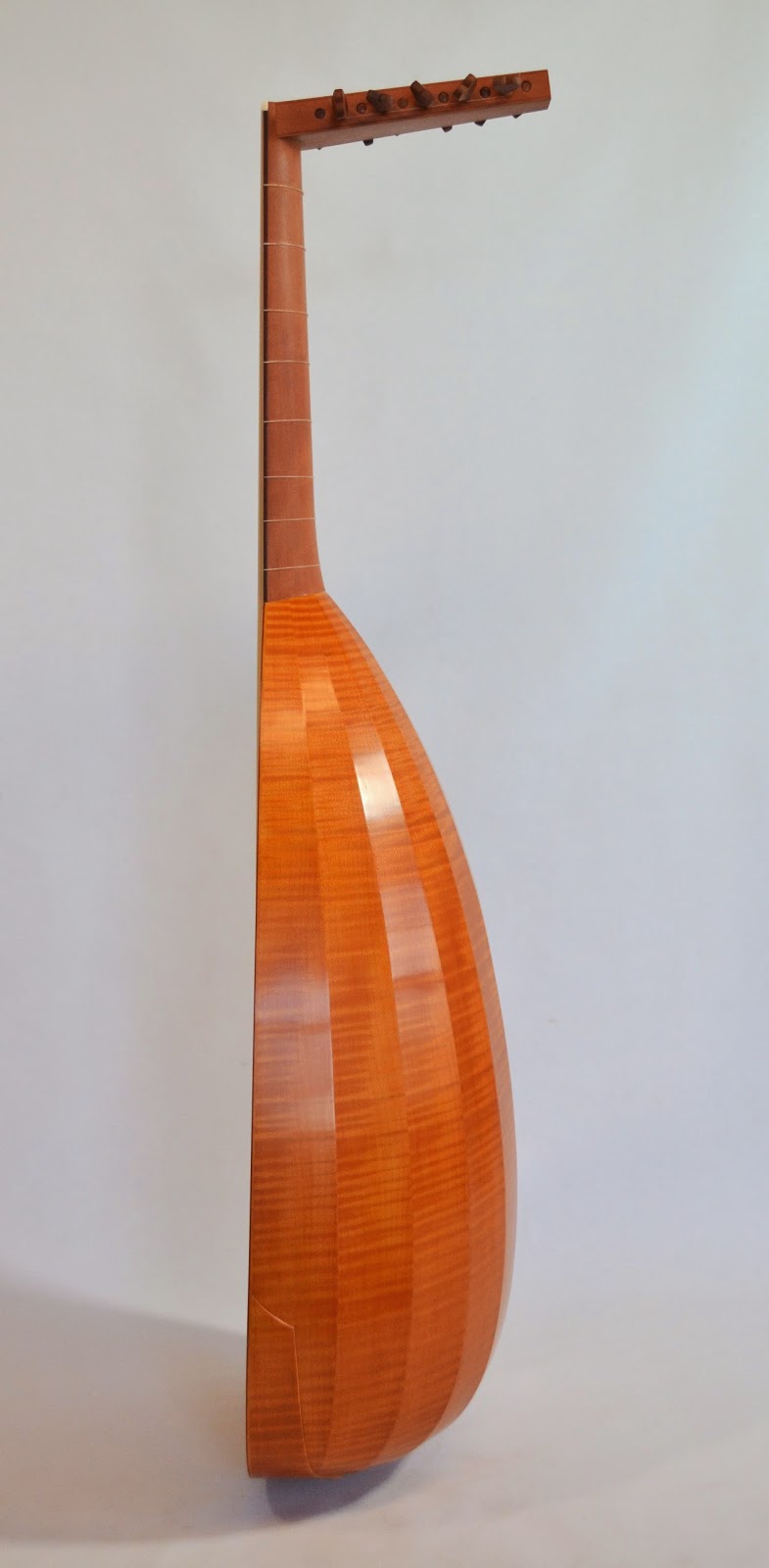First up is an 8c lute based on the Tieffenbrucher archlute, C45 in the Vienna Kunsthistorisches Museum. My version here is reduced to about 95% of the original body, which allows for a slightly shorter string length (this lute has a string length of 63cm, with 9 frets tied on the neck). This lute was made for Dr. Ken Lee of Vancouver.
The back is of Honduras rosewood (with holly spacers), a wood that I haven't used for this model before. My initial impressions of it are that it creates a very powerful, clear and focused tone. It's perhaps not the most complex tone that you might hope for, but it is quick and strong. I think it will make a very nice concert instrument; my impression is that it could fill a small hall (relatively) effortlessly.
My client had some specific requests for this lute. He asked for both the first and second course to be single strung; he also asked for a set of mechanical pegs (Pegheds) to be installed. I find that I'm being asked to install these pegs more frequently, which I don't really a problem with, though it does hurt my pride in my own traditional wooden peg-making and fitting just a teeny bit. In my limited experience, the Pegheds seem to work well, though I must say they are not without difficulty to install.
 One other unusual request by my client was the rose design: the rose from the 1592 Venere lute in Bologna. I usually think of this pattern as belonging to that particular model of instrument (since it's the only surviving historical instrument on which it appears), but that's no reason not to use it elsewhere. I think it works well on this lute.
One other unusual request by my client was the rose design: the rose from the 1592 Venere lute in Bologna. I usually think of this pattern as belonging to that particular model of instrument (since it's the only surviving historical instrument on which it appears), but that's no reason not to use it elsewhere. I think it works well on this lute.The next recently completed lute is a 6c version of the Warwick Frei lute. I've made a number of 11c versions, but this is the first 6c version I've done of this lute. It has quite a long string length at 71cm, but I must say I felt no difficulty in playing it--the shape of the body seems to fit easily against the player's body, and once one finds a correct way of holding it, it is quite comfortable to play. I made this lute for Sten Hansen of St. Charles, IL.
The most unusual aspect of this instrument, for me, was the thickness of the soundboard and the dimension, number and location of the soundboard braces. As outlined in my last blog post, I used barring and soundboard thicknessing that corresponded with the evidence that I saw in the historical lute: an unusually thick belly, a five-bar brace pattern, and a j-bar that spanned the width of the belly. These may seem like small adjustments on their own, but taken together they are, I think, a fairly radical departure from conventional systems (or at least my own conventional systems).
I think the experiment was a resounding success (but I guess you should ask Sten about that to be sure). The lute has quite a big sound, with a bright, singing chanterelle and a strong response across the whole range. The timbre of the instrument is...well...unique. I haven't heard anything quite like it, and I'm a little baffled at how to describe it. (This is an ongoing issue for me--how to describe a sound. Sten and the lute will be in Cleveland next week, at the Lute Society of America Summer Seminar, and I plan on listening for people's responses, and collecting their adjectives. I will report back in a future blog post.)
The rose pattern, as I've said before, is one of my favourites, both to look at and to carve.
And I love the way so many different woods arrive at one point, here at the body-neck joint: pear neck and fingerboard, snakewood fingerboard edging, curly maple ribs, spruce soundboard, pear belly edging, boxwood frets.
Last of The Unusuals is the most unusual of all: a five course, fretless medieval lute, built for Gus Denhard of Seattle. This one is so unusual I will devote an entire future post to its design and construction. This one stretched me to the limits of my craft skills unlike any other I've made. At the risk of sounding a bit cocky, after building this one, I think I could build just about anything.
The broad-ribbed, nearly semicircular back, along with the ribs re-curving into the neck were a fair challenge, but the tile work on the belly and herringbone edge binding--both shop-made--were no less tricky. I'm quite pleased with the result.
Gus came to my workshop this week to pick up the lute, and in his hands it sounded great. I think this lute has been a dream of his for a while, and now that he has it, he will be the one to create its repertoire. That's a great reward for me, to be able to create the vehicle for another person's musical adventure. A lot of the time, I feel like the luckiest guy on the planet.
And that is all for today. I'm off to the LSA Seminar in Cleveland tomorrow--I hope to see you there!














No comments:
Post a Comment